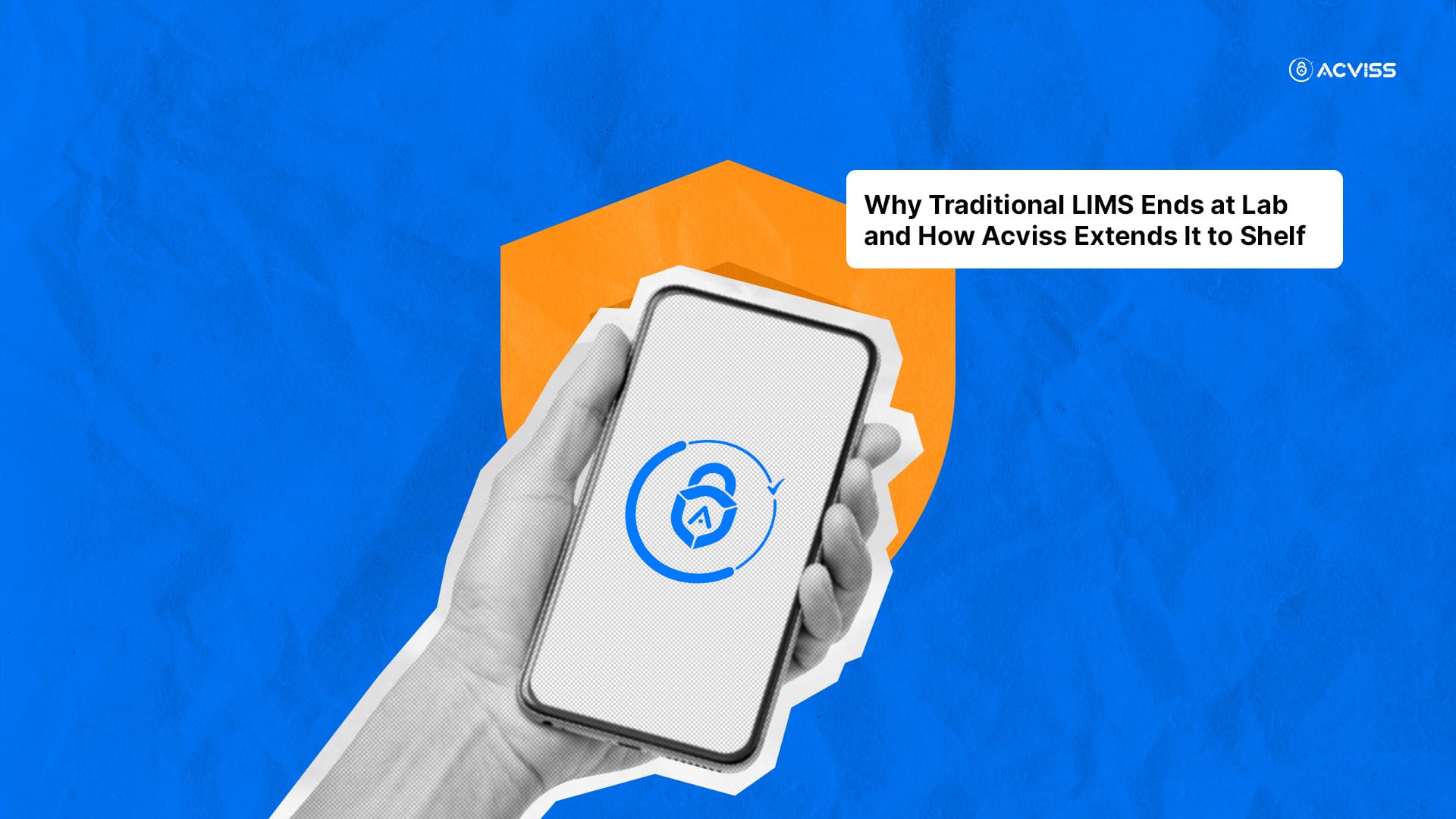Why Traditional LIMS Ends at Lab and How Acviss Reaches the Shelf

Every brand that invests in product quality testing places enormous trust in its Laboratory Information Management System (LIMS). These systems are built to ensure accuracy, compliance, and efficiency within laboratory environments, a backbone of regulated industries like pharmaceuticals, agrochemicals, food processing, and FMCG.
However, here lies the uncomfortable truth: most LIMS implementations stop at the lab door.
They meticulously capture test results, record batch IDs, and generate compliance-ready reports. Yet, the moment a batch leaves the laboratory, the visibility ends. The tested, verified, and compliant product data that resides securely within servers no longer has a digital tether to the products distributed in the market.
That means once a product moves from the controlled environment of the lab to the uncontrolled world of manufacturing lines, warehouses, and retail shelves, the chain of verified authenticity is broken.
For industries that rely heavily on trust, whether it’s a medicine that saves lives or a pesticide that protects crops, this disconnection creates a critical blind spot. Counterfeits, adulteration, mislabelling, and substitutions can infiltrate at any point along the supply chain. And without a system to connect lab-tested data to the end product, the market often operates on assumptions rather than assurance.
The Problem: Verified Quality Stays Trapped in the Lab
The fundamental limitation of traditional LIMS is not in what it does, but in where it stops.
LIMS platforms were originally built to manage laboratory workflows, handling everything from sample management to test scheduling and compliance documentation. They excel at internal efficiency, but they are not designed for end-to-end product visibility.
Once a batch clears quality testing, the verified attributes, such as purity, formulation, composition, or stability, remain locked within a database. The manufacturing or packaging team typically receives only summary reports, often through emails, PDFs, or printed documents.
At this point, the “verified identity” of the batch becomes invisible. When the same batch moves into packaging or distribution, there is no guaranteed way to confirm whether the product on the shelf is the same one that passed quality testing.
This gap in traceability leads to three major risks:
1. Disconnected Quality Verification

There’s no digital link between lab data and the actual market product. Any product could claim to be from a “tested” batch, but the system cannot prove it. This opens doors for counterfeiters and unauthorised distributors.
2. Inefficient Recall and Investigation
When a product recall occurs, brands often struggle to trace which batches were affected. Teams spend days, even weeks, combing through physical records and cross-referencing reports. The process delays responses and heightens regulatory risk.
3. Compliance without Continuity
Regulatory bodies demand proof that tested batches match the products sold in the market. Yet, LIMS systems alone cannot verify this continuity once the batch exits the lab’s controlled environment.
In short, while LIMS ensures quality assurance inside the lab, it fails to ensure quality continuity outside it, exactly where market risks begin to multiply.
The Shift: From Data Storage to Data-Carrying Products
For years, the industry has treated quality data as something to be stored, not shared, and certainly not embedded within the product itself. But as global supply chains grow more complex and counterfeiting becomes more sophisticated, that paradigm is shifting.
Quality shouldn’t live in a server. It should travel with the product.
Imagine a world where every single product on the shelf, whether a vial of vaccine, a packet of seeds, or a bottle of milk, can digitally prove its lab-tested origin. With a simple scan, it reveals when and where it was validated, who tested it, and the results that confirmed its authenticity.
That’s no longer imagination. That’s the frontier of product integrity, and it’s where Acviss Origin extends the power of traditional LIMS into the real world.
The Solution: Extending LIMS Data to the Market with Acviss Origin

Acviss Origin bridges the critical gap between laboratory data and market presence by transforming static LIMS information into live, traceable product intelligence.
It connects every batch tested in the lab to each product that reaches the consumer, using non-cloneable, QR-based digital identities that enable real-time product traceability.
This isn’t just track and trace, it’s the digital continuity of verified authenticity from lab to shelf.
How It Works
1. Batch-to-Code Mapping
As soon as a batch clears laboratory testing, its LIMS data, including test ID, parameters, batch number, testing date, and lab validation records, is securely linked to a unique digital identity within the Acviss Origin system.
This ensures that the verified test data is cryptographically bound to the batch, forming the foundation for digital product verification.
2. Serialisation and QR Tagging
During the packaging phase, every product unit or carton is given a unique, non-cloneable QR code. This QR identity is linked directly to its verified LIMS batch data.
Unlike traditional barcodes, Acviss’s non-cloneable technology ensures each code is impossible to replicate or reuse, offering unparalleled protection against counterfeiters and grey-market diversions.
3. Real-Time Traceability Across the Chain
As these products move through manufacturing, warehousing, logistics, and retail, each scan updates the Acviss Origin platform. This creates a live, tamperproof digital record of the product’s journey, from the moment it passes lab testing to the moment it reaches a customer’s hand.
4. Verification at Every Step
Stakeholders, be it distributors, retailers, regulators, or consumers, can scan the code and instantly verify:
“Yes, this pack belongs to a lab-tested, verified batch.”
This level of end-to-end product authentication eliminates guesswork, enabling brands to enforce true data-driven transparency.
How This Transforms Quality Management
The integration of Acviss Origin with traditional LIMS systems doesn’t merely enhance visibility; it redefines how brands perceive quality assurance. It extends laboratory integrity into the marketplace, allowing every stakeholder to interact with verified data directly.
1. Proven Quality Beyond Compliance
Instead of “tested” being a claim on a report, it becomes an interactive, digital proof carried by every product. Brands can demonstrate verified quality instantly to auditors, distributors, and consumers alike, fostering brand trust and regulatory confidence.
2. Fast, Targeted Recalls
In the unfortunate event of a contamination or quality deviation, brands can trace affected products instantly down to the smallest unit. No more market-wide recalls or operational disruptions, just precise, data-backed intervention.
3. Real-Time Market Intelligence
Every product scan feeds data back into the system, giving brands and quality teams real-time visibility of product movement and performance. This empowers decision-making across supply chain management, sales forecasting, and compliance tracking.
4. Counterfeit and Diversion Protection
The non-cloneable QR codes act as a digital fortress for each product. Counterfeit or untested items can no longer mimic genuine, lab-tested products. Acviss’s advanced anti-counterfeiting solutions ensure that every scan verifies authenticity against the verified LIMS record.
5. Consumer Trust at Scale
Customers today expect transparency. When a consumer can scan a pack and instantly see its verified batch information, test date, origin, and authenticity, it transforms their perception of the brand. It’s not just brand protection anymore; it’s brand engagement that fuels loyalty and satisfaction.
Industry Applications

a. Pharmaceuticals
For the pharmaceutical industry, where precision and safety are paramount, connecting LIMS data with Origin ensures that every drug or vaccine on the market is traceable back to its lab-tested source.
If a compliance issue arises, the brand can quickly identify affected medicines, meet regulatory requirements, and maintain public trust.
b. Agro-Chemicals
In agriculture, counterfeit or diluted chemicals can devastate yields and ecosystems. With Origin, every bottle or sachet can be digitally tied to its lab-verified batch.
When farmers scan the product, they confirm its authenticity and efficacy, safeguarding both crops and livelihoods.
c. FMCG & Food
Consumers today are more aware of product safety than ever before. Brands promoting “purity tested” or “lab verified” can now actually prove it.
By linking LIMS data to QR codes, product authenticity and trust become visible in real time, helping brands maintain their reputation and customer loyalty even in highly competitive markets.
Benefits in Action
Impact Area | Before Acviss Origin | After Acviss Origin |
Batch Verification | Manual reports, disconnected systems | Digital link between lab data and market unit |
Recall Management | Weeks of document tracing | Instant trace-back to affected batches |
Counterfeit Detection | Visual inspection only | Cryptographically secure QR verification |
Regulatory Proof | File-based evidence | Real-time digital audit trail |
Consumer Transparency | None | Verified “tested batch” visible via QR scan |
Why It Matters
In the era of globalised supply chains and rising product fraud, the concept of “tested and trusted” is no longer enough.
Brands must ensure data continuity from laboratory certification to the market shelf. Every step, from testing and manufacturing to transport and sale, must be traceable, verifiable, and auditable.
Extending LIMS data through Origin, brands transform compliance into continuity. Each unit in circulation carries a verified digital identity, ensuring product authenticity, IP protection, and brand integrity at scale.
Moreover, it’s not just about protecting against counterfeiters; it’s about building consumer confidence through visible transparency. When customers can verify authenticity on their own, brands earn not just compliance but enduring trust.
The Larger Picture: From Lab Integrity to Market Trust
For decades, laboratories have been the gatekeepers of product quality. Yet, their influence often stops once the product leaves their facility. In contrast, Acviss Origin turns the laboratory’s verified data into a living proof of trust that travels across the supply chain, from warehouse to retail to consumer.
In doing so, it solves one of the most persistent industry challenges: how to ensure that what’s tested in the lab is exactly what reaches the customer.
By integrating LIMS with product traceability technologies, Origin builds a bridge between internal quality systems and external brand reputation, aligning compliance, safety, and customer satisfaction within a single digital framework.
The Future of Data-Driven Trust

The world is moving toward transparency. Governments are tightening regulations, consumers are demanding proof, and counterfeiters are becoming more sophisticated.
Traditional LIMS can no longer meet these dynamic demands alone. They need to evolve from static data repositories into connected ecosystems where quality, authenticity, and safety coexist seamlessly.
With Acviss Origin, brands step into that future today, where every tested batch tells its own verified story, every product carries its traceable journey, and every customer interaction strengthens brand authenticity.
Key Takeaways for Brands
- Traditional LIMS systems end their visibility at the lab, leaving the market disconnected from verified data.
- Origin bridges this gap by linking lab-tested data directly to product units via non-cloneable QR identities.
- The integration enhances brand protection, anti-counterfeiting, product traceability, and customer engagement simultaneously.
- Brands gain a real-time track and trace mechanism for recall management, compliance audits, and consumer transparency.
- Ultimately, it transforms compliance from a regulatory requirement into a strategic advantage for trust and growth.
Conclusion
The quality you prove in your lab should not vanish at the factory gate. It should follow every product, every shipment, and every customer interaction.
Traditional LIMS systems may protect your data, but Acviss Origin protects your reputation. By extending lab intelligence to the shelf, brands can ensure that every product is verifiably authentic, every batch is traceable, and every customer interaction reinforces trust.
In an interconnected world where authenticity defines success, that’s the future every brand deserves.
Interested to learn more?
Discover how Acviss Origin can bridge your lab data with real-world traceability and redefine quality assurance for your brand. Get in touch with us today.
